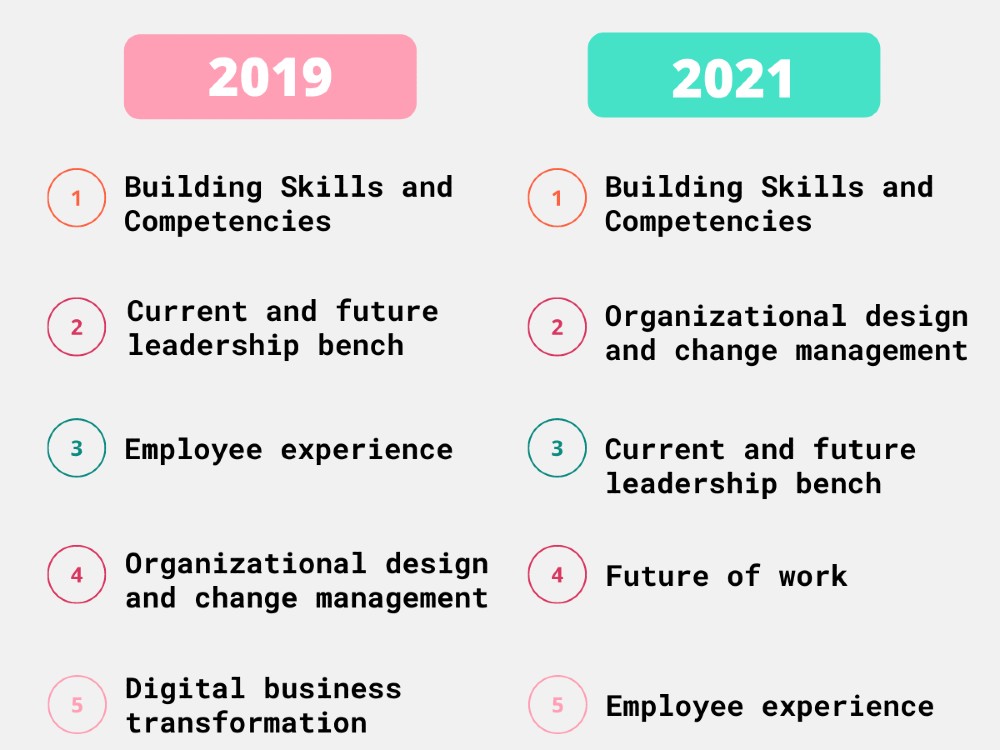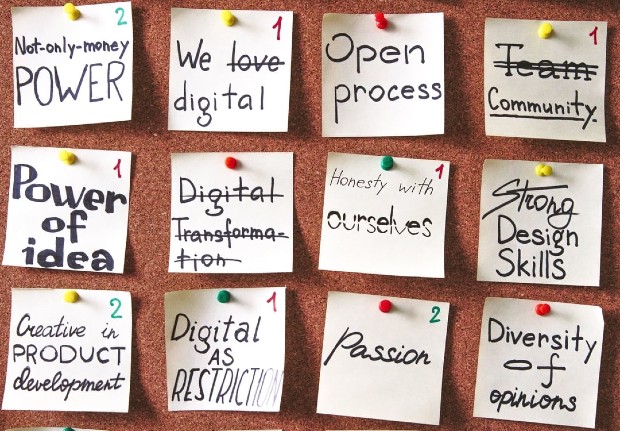Talking about how the world has changed since the start of the COVID-19 pandemic is long past being a cliche’. The pandemic accelerated digital adoption, made remote work the norm, and was a catalyst for change for everyone. HR leaders can probably write novels about the number of challenges they’ve faced and are facing in the wake of the continuing crisis. But how much has truly changed in the last couple of years? As with everything we do at GrowthSpace, we decided to look at the data.
Gartner surveys HR leaders every year to understand their priorities. We looked at the survey results from 2019 and compared those to the 2021 survey. While some changes were surprising, others were predictable. Let’s dig in.
The Rankings
Here are the top 5 side-by-side:

2019 to 2021 – What Didn’t Make the Cut?
There’s one clear omission between 2019 and 2021: Digital business transformation. This isn’t particularly surprising. Digital transformation was a slow-moving process, which accelerated rapidly once the pandemic hit. We can only assume that this is no longer a priority because the digital transformation has already happened.
Changing Tides are Changing Priorities
Two dramatic climbers were change management, which moved up from 4th to 2nd place, and future of work, which was all the way down at 8th in 2019 and climbed all the way up to 4th in 2021. This is far from surprising considering all of the cliches we mentioned above. Things are changing rapidly, and the future of work is happening now.
According to Gartner’s findings, only 19% of HR leaders feel that their workforce is capable of changing direction effectively in the face of changing needs and priorities. Only 38% believe their workforce can effectively detect whether they’re working on the right things. Rigid processes that have been in place for years, along with overwhelmed employees, are a recipe for disaster when it comes to adjusting to the new reality. The need to redesign the way companies work is critical if businesses want to survive.
As we mentioned earlier, the digital transformation has already happened, but it has opened the door to rapidly evolving technologies and a lot of volatility. Pendulum swings in the market and a still-evolving global crisis is making HR leaders focus more heavily on individual resilience. The shift to a remote work environment has made companies understand the importance of employee data to empower digital communication and workflows. To further complicate things. AI and automation are making some jobs practically obsolete, and transforming others completely. Managing those ramifications is a challenge HR leaders are dealing with already, and they will only become broader and more complex.
Employee Experience Gets Downgraded?
We were surprised to find that despite all of the challenges outlined above, employee experience has come down in the rankings from #3 in 2019 to #5 in 2021. Moving to a remote work environment has definitely created new challenges with maintaining company culture and employee’s sense of belonging.
According to Gartner, nearly half of all employees are working remotely at least part of the time. This is compared to 30% pre-pandemic. Of course, this brings on a host of challenges- from hiring and onboarding to identifying high-potential individual contributors, and finding growth opportunities despite a more fragmented work environment.
So why did this come down on the list? Well, we posit that it didn’t. The problem has just become more complex than it has been in the past, and it’s now inextricably linked to every one of the other challenges that made the list.
Learning and Development Comes Out on Top
Strengthening the current and future leadership bench may have dropped down slightly in priority, but it still makes the top 3 in 2021. HR leaders cite diversity issues, cumbersome processes, developing mid level managers as their biggest challenges.
But more remarkable than this need is the fact that with all of the changing tides, building critical skills and competencies is still as important and as challenging to HR leaders as it ever has been.
71% of them report that more than 40% of their employees have needed to learn new skills as a result of COVID-19. 31% cited specifically that they’ve found it challenging to create development solutions to meet the growing need for them. 36% specifically said it was challenging to address the precise gaps in employee development.
So the priority is just as high as it ever was. But as with everything else, the pandemic has put a greater spotlight on problems that were already there, and amplified the need to address them head on.
It’s All About Data
What is clear from all of these findings is that we are at an inflection point, where HR leaders need to transform how they think about their programs. At the end of the day, the key to tackling all of these challenges is data.
When people moved their content consumption to the digital world in the early 2000’s marketers had to evolve and embrace data as a way to understand where their budgets were going, and what strategies would help them succeed.
Now, when work has fully moved into the digital world, it’s time for HR leaders to harness the power of data in everything they do.
Learning and Development is an area where harnessing data effectively can cause a seismic shift in priorities, and unlock endless possibilities. For example, HR leaders who use GrowthSpace can leverage data to match employees with just the right expert for the precise challenge they face, map that to business KPIs, and measure the effectiveness of their LnD programs across the entire organization – at scale.
Regardless, it’s clear that even though the challenges are vast, the move to a digital-first work environment opens up a world of possibilities for HR leaders. This is a #momentofgrowth , and it’s time to grab the bull by the horns and embrace the ride.




